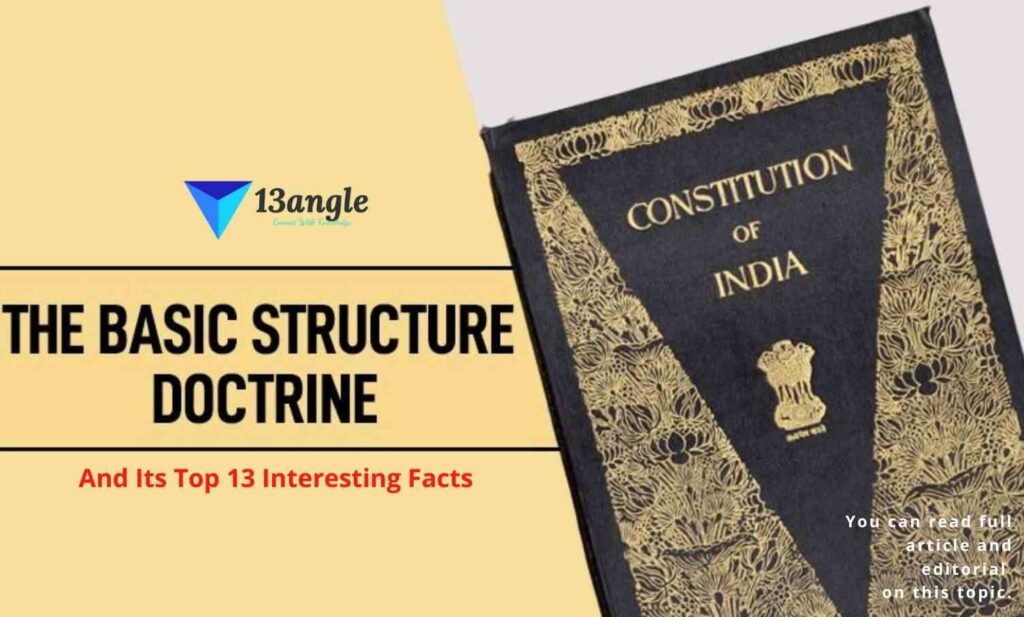The case of Keshavanand Bharati v. the State of Kerala is possibly the most well-known Supreme Court of India constitutional ruling. While there is no inherent constraint on Parliament’s ability to alter the Constitution, it was held that no modification can harm the Constitution’s fundamental structure (the “Basic Structure Doctrine”). Furthermore, it established the Supreme Court’s right of review and, as a result, its constitutional supremacy.
This ruling may be credited with helping to preserve India’s parliamentary democracy. However, as some of the case’s ramifications become clearer, it’s clear that the case’s complication and lack of clarity on key issues left much to be resolved by posterity.
The most important of these is the debate over the Constitution’s fundamental framework. While overturning a previous Supreme Court decision in Golak Nath v. State of Punjab, which held that constitutional amendments cannot infringe on fundamental rights, Keshavananda Bharati left open the possibility of a judicial opinion on whether any amendment to a fundamental right can be said to amend the Basic Structure. With a hearing that lasted over 60 days, eleven separate judgments handed down, an 800-page ruling, and Chief Justice Sikri’s controversial “View by the Majority,” disagreement over the ratio’s meaning have persisted to this day.
The dispute that led to the formation of Keshavananda Bharati began with a disagreement over the interpretation of Article 368 of the Indian Constitution, which permits Parliament to modify the Constitution. While the Article itself is clear, the scope and extent of Parliamentary power to amend the Constitution has been a contentious issue, culminating in the Golak Nath decision, in which the Supreme Court held that Parliament did not have the power to amend the fundamental rights under Part III of the Indian Constitution when exercising its power to amend the Constitution. The Golak Nath decision was met with strong legal and political criticism almost immediately after it was handed out. Many saw it as a political choice that limited Parliament’s ability to modify the Constitution.
Two years after Golak Nath, the government of Mrs. Indira Gandhi, then Prime Minister of India, nationalized 14 banks with minimal compensation. This ruling was quickly appealed to the Supreme Court. The Supreme Court in R.C. Cooper v. Union of India struck down the Bank Nationalization Act, 1969 due to its compensation component, while upholding Parliament’s right to nationalize banks. The government next attempted to abolish Privy Purses, which were payments made by the Indian government to former princes at the moment of independence. The Supreme Court struck down the Presidential order that resulted in the above abolition in Madhav Rao Scindia v. Union of India.
Following these Supreme Court reversals, the Indian government enacted a slew of constitutional amendments to supersede the Supreme Court’s rulings:
- The Constitution (24th Amendment) Act of 1971 added a clause (4) to Article 13 that protects Article 368 from Article 13’s action. Clauses (1) and (3) were also added to Article 368 in order to limit the scope of Article 13 and to clarify the difference between Parliament’s amending and legislative powers.
- The Constitution (25th Amendment) Act of 1971 amended Article 31 of the Constitution, allowing the government to acquire private property more easily.
- Parliament overturned the Supreme Court’s decision in the Privy Purses case with the Constitution (26th Amendment) Act of 1971.
Those who were harmed by the Constitutional revisions filed a lawsuit in the Supreme Court, laying the stage for a constitutional war between two legal principles: Parliament’s unconstrained ability to amend the Constitution and constitutional limitations on such power.
Kesavananda Bharati involved six separate writ petitions filed by various petitioners representing the property class, landowners opposed to land ceiling legislation, Maharashtra sugar corporations, coal mining companies, and former princes trying to keep their previous privileges. The writ petitions questioned whether, as decided in the Golak Nath case, Parliament’s jurisdiction to change the Constitution, notably the fundamental rights, was limited.
His Holiness Keshavananda Bharati Sripadagalvaru, the leader of a Kerala Math (Religious Institution), was the principal petitioner, challenging the Constitution (29th Amendment) Act, 1972, which included the Kerala Land Reforms Act, 1963, and its amending Act to the IX Schedule of the Constitution. To hear the case, a panel of 13 judges was formed. The bench ruled by a seven-six majority that Parliament’s ability to amend the Constitution was not explicitly limited but was confined to not altering or amending the Constitution’s core elements or structure. In court, eleven different decisions were made orally.
During the announcement, the then Chief Justice of India, Sikri circulated a paper titled “View by the Majority,” which contained six propositions, including Proposition No. 2: “Article 368 does not allow Parliament to change the Constitution’s core structure or framework.” This proposition, taken from Justice Khanna’s decision, has become known as the Keshavananda Bharati ratio. Only nine of the thirteen Judges signed the “View by the Majority,” which is significant.
In the case of Keshavananda Bharati, the Supreme Court affirmed the challenged Land Reform Acts and Amendment Acts. The sole provision of the Constitution (25th Amendment) Act that was knocked down was the part that prohibited judicial review. Aside from the restriction on Parliament’s capacity to change the basic structure, the case was a win for the government.
The concept’s intrinsic ambiguity, as well as the ratio in Keshavananda Bharati, resulted in numerous challenges before the Supreme Court, both to and under the doctrine. Following Keshavananda Bharati, the concept grew on a case-by-case basis, eventually resulting in the progressive development of the doctrine.
A constitutional amendment to regularise Prime Minister Indira Gandhi’s election was struck down in Indira Gandhi v. Raj Narain, citing the fundamental features of democracy, rule of law, and equality. The Constitution (42nd Amendment) Act, 1976, aimed to circumvent Keshavananda Bharati by making Parliamentary power unlimited in Minerva Mills v. Union of India. The amendment was struck down by the Court in this case because judicial review of Parliamentary enactments and the limits of Parliamentary power to modify the Constitution were both part of the Constitution’s essential structure.
Since 1975, the courts have interpreted and expanded the doctrine to include judicial review of High Court and Supreme Court decisions under Articles 226 and 32, secularism and federalism under Article 19, judicial independence, and, most recently, judicial primacy in the judicial appointment process to the Constitution’s basic structure and framework.
The Supreme Court did not rule on whether an amendment to the Ninth Schedule would render the mentioned statute free from the necessity of not infringing on a fundamental right until much later. The Supreme Court held in IR Coelho v State of Tamil Nadu that all laws must pass the test of being consistent with fundamental rights, which are a part of the Basic Structure Doctrine thereby, bringing a change that totally revolutionized the role of Judiciary in our country, curbing inherently, the unprecedented galloping powers of the Parliament to amend and enact laws.

For deep details, you can read the full article. Click the link below :





